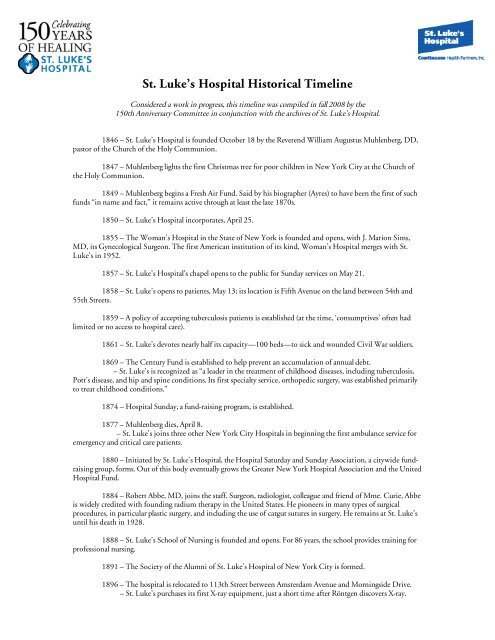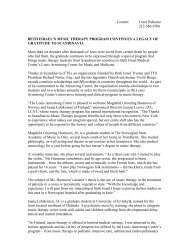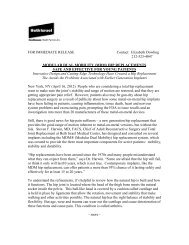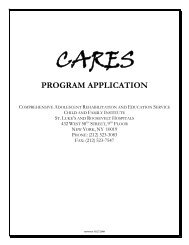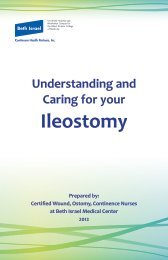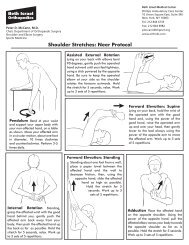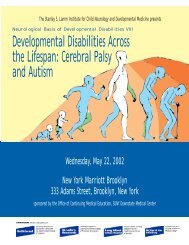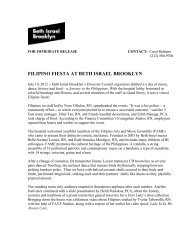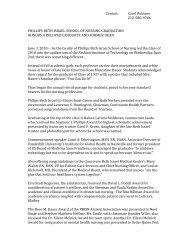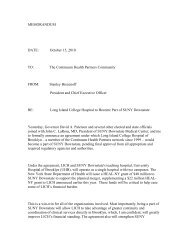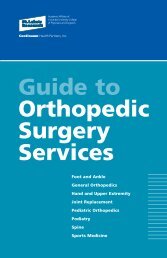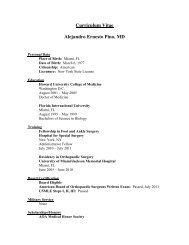Microsoft Word - SL_Timeline011209web.doc - Continuum Health ...
Microsoft Word - SL_Timeline011209web.doc - Continuum Health ...
Microsoft Word - SL_Timeline011209web.doc - Continuum Health ...
You also want an ePaper? Increase the reach of your titles
YUMPU automatically turns print PDFs into web optimized ePapers that Google loves.
St. Luke’s Hospital Historical Timeline<br />
Considered a work in progress, this timeline was compiled in fall 2008 by the<br />
150th Anniversary Committee in conjunction with the archives of St. Luke’s Hospital.<br />
1846 – St. Luke’s Hospital is founded October 18 by the Reverend William Augustus Muhlenberg, DD,<br />
pastor of the Church of the Holy Communion.<br />
1847 – Muhlenberg lights the first Christmas tree for poor children in New York City at the Church of<br />
the Holy Communion.<br />
1849 – Muhlenberg begins a Fresh Air Fund. Said by his biographer (Ayres) to have been the first of such<br />
funds “in name and fact,” it remains active through at least the late 1870s.<br />
1850 – St. Luke’s Hospital incorporates, April 25.<br />
1855 – The Woman’s Hospital in the State of New York is founded and opens, with J. Marion Sims,<br />
MD, its Gynecological Surgeon. The first American institution of its kind, Woman’s Hospital merges with St.<br />
Luke’s in 1952.<br />
1857 – St. Luke’s Hospital’s chapel opens to the public for Sunday services on May 21.<br />
1858 – St. Luke’s opens to patients, May 13; its location is Fifth Avenue on the land between 54th and<br />
55th Streets.<br />
1859 – A policy of accepting tuberculosis patients is established (at the time, ‘consumptives’ often had<br />
limited or no access to hospital care).<br />
1861 – St. Luke’s devotes nearly half its capacity—100 beds—to sick and wounded Civil War soldiers.<br />
1869 – The Century Fund is established to help prevent an accumulation of annual debt.<br />
– St. Luke’s is recognized as “a leader in the treatment of childhood diseases, including tuberculosis,<br />
Pott’s disease, and hip and spine conditions. Its first specialty service, orthopedic surgery, was established primarily<br />
to treat childhood conditions.”<br />
1874 – Hospital Sunday, a fund-raising program, is established.<br />
1877 – Muhlenberg dies, April 8.<br />
– St. Luke’s joins three other New York City Hospitals in beginning the first ambulance service for<br />
emergency and critical care patients.<br />
1880 – Initiated by St. Luke’s Hospital, the Hospital Saturday and Sunday Association, a citywide fundraising<br />
group, forms. Out of this body eventually grows the Greater New York Hospital Association and the United<br />
Hospital Fund.<br />
1884 – Robert Abbe, MD, joins the staff. Surgeon, radiologist, colleague and friend of Mme. Curie, Abbe<br />
is widely credited with founding radium therapy in the United States. He pioneers in many types of surgical<br />
procedures, in particular plastic surgery, and including the use of catgut sutures in surgery. He remains at St. Luke’s<br />
until his death in 1928.<br />
1888 – St. Luke’s School of Nursing is founded and opens. For 86 years, the school provides training for<br />
professional nursing.<br />
1891 – The Society of the Alumni of St. Luke’s Hospital of New York City is formed.<br />
1896 – The hospital is relocated to 113th Street between Amsterdam Avenue and Morningside Drive.<br />
– St. Luke’s purchases its first X-ray equipment, just a short time after Röntgen discovers X-ray.
2<br />
1897 – Francis Carter Wood, MD, joins the staff of St. Luke’s. Surgeon, pathologist, friend and<br />
collaborator of Mme. Curie, Wood pioneers in the diagnostic and therapeutic use of X-rays and is internationally<br />
renowned for his research into the causes and treatment of cancer. He organizes the pathology laboratory at St.<br />
Luke’s and directs it from 1910 through 1947. In 1921, he establishes St. Luke’s Radiotherapy Department and<br />
serves as its director until 1947.<br />
1898 – St. Luke’s opens and sets aside 30 beds for the use of soldiers and sailors during the Spanish-<br />
American War.<br />
1906 – The Plant Pavilion opens, the gift of Margaret J. Plant.<br />
1910 – Hans Zinsser, MD, co-authors a textbook of bacteriology. In subsequent editions retitled Zinsser<br />
Microbiology, it remains the classic text in the field for decades.<br />
1911 – The Travers Pavilion opens, the gift of Mrs. John G. Heckscher.<br />
1914 – The Social Service Department opens.<br />
– Eye, Ear, Nose and Throat Wards open.<br />
1917 – Following America’s entry into World War I, St. Luke’s opens a “Military Ward” for the care of<br />
recruits and soldiers.<br />
1922 – St. Luke’s institutes radio reception for patients; it is among the first hospitals in New York City<br />
to do so.<br />
1925 – Mary Breckinridge, a School of Nursing graduate, establishes the now world-famous Frontier<br />
Nursing Service. Begun as a means of bringing nursing care to isolated areas of the Blue Ridge Mountains of<br />
Appalachia, the nurses initially travel on horseback. The service currently provides comprehensive family-centered<br />
health care.<br />
1927 – St. Luke’s Convalescent Home opens in ByramWoods, Greenwich, CT.<br />
1928 – The Scrymser Pavilion opens, the gift of Mrs. James (Mary Catherine Prime) Scrymser.<br />
1930 – Mather Cleveland, MD, joins the staff and establishes the first orthopedic department<br />
incorporated in a general hospital in New York City.<br />
1934 – Morris K. Smith, MD, an intern at St. Luke’s in 1911, joins the staff. Surgeon, member of<br />
multiple professional societies, and generous contributor to the literature, he is acclaimed for his service during<br />
World Wars I and II. Among other work, he serves as Surgical Consultant to the 3rd Army in France and Germany.<br />
He is awarded the Bronze Star.<br />
1935 – St. Luke’s surgeons Henry Lyle, MD, and Alexander Ada, MD, perform one of the earliest<br />
successful removals of a cancerous lung.<br />
– Pediatric patients are assigned a full-time teacher by the New York City Board of Education; the<br />
program lasts into the 1980s.<br />
1937 – The 13-story art deco Nurses’ Residence opens, the gift of Mary Ann White Fitzgerald in memory<br />
of her late father, Eli White.<br />
– David Bosworth, MD, first describes internal splinting as a method of treating metacarpal<br />
fractures. He goes on to design Bosworth screws for acromioclavicular separation and the Bosworth technique for<br />
insertion of bone pegs. In 1947, he describes a specific type of fracture of the distal fibula named the Bosworth<br />
fracture. In 1949, he pioneers in the surgical treatment, including spinal fusion, for tuberculosis of the spine. (This<br />
takes place before anti-tubercular drugs become available.)<br />
1938 – Urology Department opens with 24 beds.<br />
1939 – St. Luke’s acquires a laminagraph, an X-ray machine that makes radiography of body tissue<br />
possible at any desired depth. At the time, it is the first and only unit in New York State, one of only nine in the<br />
USA, and one of only 14 in the world.
3<br />
– The Board of Managers establishes the position of Director of Religious Activities and<br />
subsequently appoints Rev. Otis Radcliffe Rice as director. Under his direction, the department is said to have<br />
become a model for planning hospital religious departments throughout the country.<br />
1940 – By request of the surgeon general, St. Luke’s begins assembling Evacuation Hospital #2. Staffed by<br />
St. Luke’s MDs and nurses, the mobile unit serves abroad in seven different countries.<br />
– A new state-of-the-art Physical Therapy Department opens. Serving all medical divisions, it<br />
registers 20,000 patient visits by the end of its first year.<br />
1942 – The Blood and Plasma Bank opens; the suite of rooms includes blood testing and plasma<br />
processing facilities.<br />
1947 – Columbia affiliation signed. The formal agreement provides for St. Luke’s to give clinical<br />
instruction and practice to senior medical students, while Columbia is to provide advanced instruction in the basic<br />
sciences to St. Luke’s house officers pursuing advanced training.<br />
1949 – Poliomyelitis service inaugurated. When New York City’s two contagious diseases hospitals<br />
(Willard Parker and Kingston Avenue) become overwhelmed with patients, St. Luke’s—unique among the city’s<br />
voluntary hospitals—accepts and treats the overflow.<br />
1951 – Frederick Thompson, MD, develops the Thompson prosthesis. Initially used to treat arthritic<br />
hips and later fractures, it replaces the femoral head with a metal alloy and is the precursor of the modern total hip<br />
replacement<br />
1952 – St. Luke’s merges with the Woman’s Hospital, forming St. Luke’s Hospital Center.<br />
1953 – A.L. Loomis Bell, Jr., MD, becomes director of the cardiopulmonary laboratory.<br />
1954 – The Clark Building opens, the gift of Mrs. J. Ambrose (Florence Stokes) Clark.<br />
1955 – Richard B. Stark, MD, joins the staff of St. Luke’s and establishes the Division of Plastic Surgery,<br />
as well as the internationally renowned Cleft Palate Center.<br />
1956 – Hugh Fitzpatrick, MD, performs the first open heart repair of a septal defect in New York City.<br />
1957 – Theodore VanItallie, MD, returns to St. Luke’s Hospital to chair the Department of Medicine<br />
and advance St. Luke’s basic and clinical research.<br />
– The Stuyvesant Pavilion opens, the gift of Augustus Van Horne Stuyvesant, Jr.<br />
1960 – Dr. VanItallie and Sami Hashim, MD, first discover and publish use of cholestyramine in the<br />
treatment of hypercholesterolemia and primary biliary cirrhosis. This is the first such drug developed to lower<br />
cholesterol.<br />
1967 – Robert Zickel, MD, describes a new fixation device for subtrochanteric femur fracture. This<br />
“Zickel nail” is the precursor of the intramedullary devices in use today.<br />
1968 – John Bertles, MD, director of the Division of Hematology, and another investigator are first to<br />
describe red cells from individuals with sickle cell disease that remain sickled even when oxygen levels are restored.<br />
Those cells are termed “irreversibly sickled cells.”<br />
1969 – Lajos von Micsky, MD, becomes chief of the Ultrasonic Division. An obstetrician/gynecologist<br />
by training, Dr. von Micsky pioneers in the development and use of ultrasound and ultrasound equipment, in<br />
particular devising a number of abdominal scanners. In 1963, he establishes St. Luke’s bioacoustical laboratory.<br />
– J. William Fielding, MD, and George Van B. Cochran, MD, perform biomechanical studies on<br />
instability of the upper cervical spine that lead to understanding the role of the ligaments in that area. As a result, Dr.<br />
Fielding popularizes and improves surgical techniques for cervical spine fusion.<br />
1970 – Richard McCray, MD, performs what is thought to be the first endoscopic gastric biopsy in the<br />
United States.<br />
– George Green, MD, begins the coronary surgery program at St. Luke’s; two years earlier, he<br />
develops and performs the first coronary artery bypass surgery using the internal thoracic artery (ITA).
4<br />
1971 – Columbia University affiliation expands. The new “full affiliation agreement” gives Columbia<br />
the opportunity “to broaden [the] clinical and research training of students” and allows St. Luke’s “the further<br />
development of the highest possible standards of patient care, community service and research which will result<br />
from the achievement of university hospital status.”<br />
– Robert McCabe, MD, describes the successful sequence of cadaver kidneys obtained at one<br />
hospital, preserved at a second, and subsequently transplanted at a third. He thus describes modern renal transplant<br />
programs involving multiple medical institutions.<br />
1974 – Robert Neuwirth, MD, performs the first hysteroscopic resection of uterine submucus myomas<br />
in the world.<br />
– A modern neonatal unit is established under Farrokh Shahrivar, MD.<br />
1975 – The first NIH-funded obesity research center in the United States is founded at St. Luke’s by<br />
Theodore VanItallie, MD<br />
– St. Luke’s establishes the first hospital-based hospice program in the United States under the<br />
direction of Chaplain Carlton Sweetser and Samuel Klagsbrun, MD.<br />
1977 – The rape intervention program, which later grows into the Crime Victims Treatment Center, is<br />
established and goes on to serve as a model for other programs around the country.<br />
1979 – St. Luke’s Hospital Center merges with the Roosevelt Hospital, forming St. Luke’s-Roosevelt<br />
Hospital Center.<br />
– The Sickle Cell Center opens under the direction of Doris Weathers, MD. It becomes an<br />
important referral center for the Harlem community.<br />
1982 – Michael Grieco, MD, and Michael Lange, MD, publish the first recognition of an unexplained<br />
immunological deficit in homosexual men, later discovered to be HIV.<br />
1983 – St. Luke’s is designated a 911 Trauma Center, one of only four in Manhattan.<br />
1985 – Robert B. Case, MD, publishes a landmark study on Type A behavior vis-à-vis survival after acute<br />
myocardial infarction.<br />
– Airlie Cameron, MD, presents the first <strong>doc</strong>umentation of improved survival with the internal<br />
thoracic artery as compared with the saphenous vein bypass in a long-term follow-up study (15 years) following<br />
coronary artery bypass surgery. The first of its kind, the study is published in 1986. A 20-year follow-up study is<br />
published in 1995.<br />
1990 – Global endometrial ablation with thermal balloons for the treatment of menstrual bleeding is<br />
developed by Robert Neuwirth, MD.<br />
1992 – A new main hospital, the Babcock Building, opens.<br />
1997 – St. Luke’s-Roosevelt enters into a partnership with Beth Israel Medical Center, forming<br />
<strong>Continuum</strong> <strong>Health</strong> Partners.<br />
1999 – The <strong>Health</strong> Education and Learning (HEAL) Center opens at St. Luke’s.<br />
2000 – The Morningside Clinic, the new home for HIV outpatient services at St. Luke’s Hospital, opens.<br />
2008 – St. Luke’s celebrates its 150th anniversary of service to patients. (The hospital is founded in 1846<br />
and opens to patients in 1858.)<br />
1/12/09


